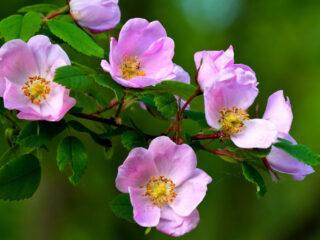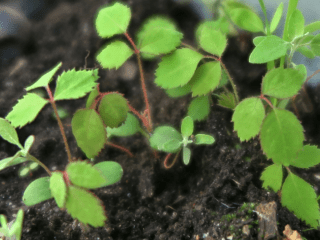Content
Spiny rose is a deciduous perennial shrub of the Rosaceae family. The plant is valued for its medicinal properties and is widely used in folk and traditional medicine. All its parts are distinguished by a high content of useful components for human health. This type of culture is also used in ornamental gardening as a stock, hedge.
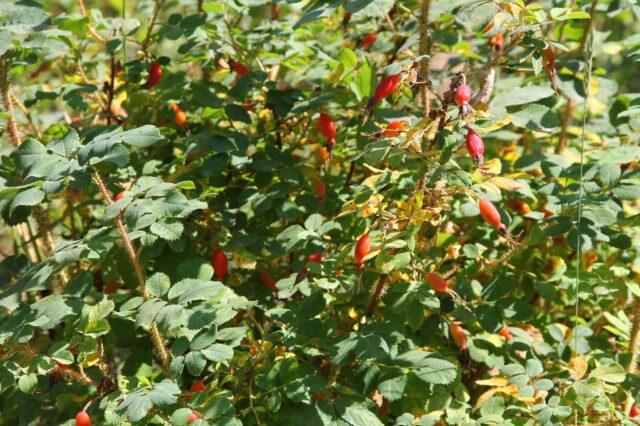
Spiny rose is considered the most cold-resistant rose
What does the description of spiny rosehip look like
The plant is a fruiting shrub, the height of which barely reaches 2 m. Shoots are arched, but sometimes erect. Initially, they are green, flexible, but as they age they become lignified and brown. The surface of the spiny rose branches is densely covered with thorns.
Leaves are compound, consisting of 7-9 separate ellipsoidal segments with a sharp end, which are attached to one long petiole. Their size reaches 11-15 cm. The surface of the plates is light green, matte. Two thin thorns are present at the base of the leaves. The petioles are also covered with fine spiny hairs. The main vein is clearly visible on the leaf plate.
Flowers of spiny rose hips are formed at the tops of the shoots. The buds are single or collected in paniculate inflorescences of 2-3 pieces. With full disclosure, the diameter of flowers in spiny rose hips is 3-5 cm. Pedicels are glandular-bristly, 0.7-3.5 cm long. The buds consist of five reverse-heart-shaped petals. The shade of flowers in the spiny rose is pink or reddish, which can be seen in the photo.
The fruits of the shrub are oval polysperms with a constriction at the top. Its length is 1.5-4 cm, and its diameter is 0.8-2 cm. The surface is smooth, when ripe it becomes bright red. Inside the fruit are light, pubescent seeds. Their length reaches 4 mm and their width is 3 mm. The mass of 1000 seeds is 8-9 g. Fruits ripen on the bush in late August - early September.
The root system of the needle rose is well developed. Its main part deepens by 15-40 cm, but the lateral processes reach a length of 5-6 m. This plant is not afraid of drought, and it also does not suffer from low temperatures down to -50 degrees.
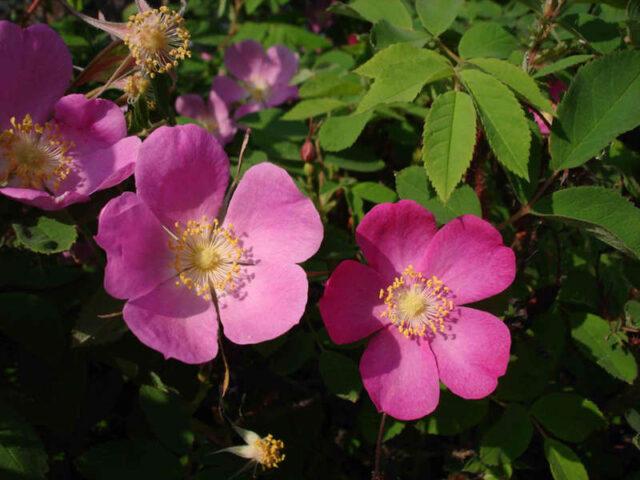
The flowering period of the spiny rose begins in June-July.
Where grows
Rosehip (Rosa acicularis in Latin) grows in the European part of Russia, and is also found in Siberia and the Urals. The shrub is common in North America, Europe, Mongolia, Japan and China.
This type of culture prefers spruce forests. Grows mostly singly on forest edges and slopes.
Chemical composition
Like all types of rose hips, the needle rose is characterized by a rich chemical composition. The roots of the plant contain tannins, catechins and flavonoids. Rosehip petals are prized for their high essential oil content. But most of all useful components are found in fruits.
They contain:
- complex of vitamins;
- organic acids;
- minerals;
- tannins;
- Sahara;
- tannins;
- pectins;
- water-soluble fiber.
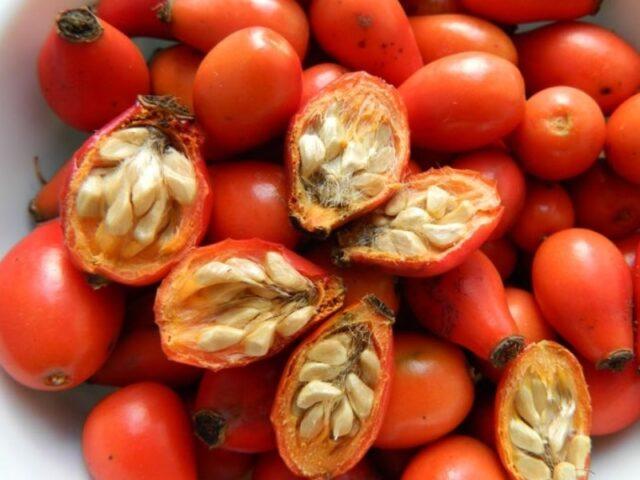
Shrub seeds are rich in vitamin E
Beneficial features
Rosehip is a unique medicinal plant. For medicinal purposes, all parts of the plant are used, but mostly the fruits. On the basis of them, drugs and remedies are prepared. These include "Holosas", which is recommended for cholecystitis and hepatitis. Rosehip oil is also widely used to treat trophic ulcers, dermatoses, bedsores, psoriasis and eczema.
The fruits of this plant are widely used in folk medicine. The funds are used for the treatment and prevention of diseases.
The main useful properties of spiny rose hips:
- strengthens the immune system;
- increases blood clotting;
- enhances the synthesis of hormones;
- activates the regenerating process;
- increases the body's resistance to bacteria, infections;
- normalizes metabolic processes;
- increases the tone of the body;
- normalizes sleep;
- strengthens blood vessels;
- removes toxins from the body;
- prevents the development of vitamin deficiency;
- promotes weight loss;
- reduces the level of bad cholesterol;
- prevents the development of heart attack and stroke.
Methods of preparation and use
In order for the needle rose to bring benefits to human health, you need to be able to properly prepare funds based on it. Only in this case, you can count on a therapeutic and prophylactic effect.
Tea
This drink helps to strengthen the body's resistance to adverse external factors. It also tones up and normalizes the nervous system, relieves fatigue, restores strength after overwork, improves brain function and relieves headaches.
Would need:
- 100 g of dried fruit rose hips;
- 1 liter of boiling water.
Cooking process:
- Place the fruits in an enamel pot.
- Pour boiling water over them.
- Simmer on low heat for 10 minutes.
- Pour into a thermos.
- Insist 10 hours.
After the waiting period, strain the tea. Drink it warm, in equal portions throughout the day.
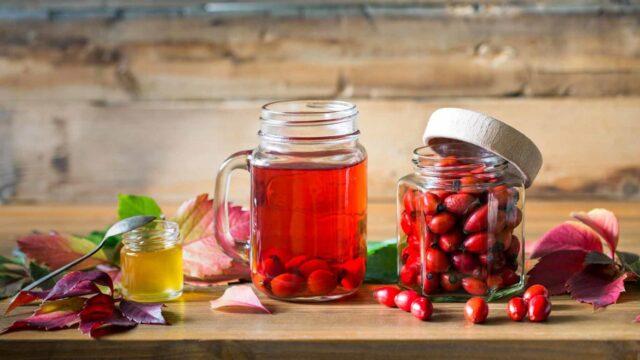
To improve the taste, honey can be added to tea based on rose hips.
Infusion
This remedy is recommended for hypo- and avitaminosis, anemia and exhaustion. It also helps with atherosclerosis, and increases the body's resistance to infections. The infusion is also recommended for weight loss. In this case, you need to drink it in 100 ml 20 minutes before meals.
Would need:
- 40 g of dried fruit rose hips;
- 1 liter of boiling water.
Cooking process:
- Wash the raw materials thoroughly and dry on a paper towel.
- Grind in a ceramic mortar.
- Pour the fruits into a thermos.
- Pour boiling water over.
- Soak for 8-10 hours, strain several times.

The infusion can also be prepared from whole fruits, but then they must be kept in a thermos for a day.
Decoction
Rosehip broth has gained popularity as a choleretic, diuretic and anti-sclerotic remedy. It is also used for uterine bleeding, loss of strength, during the rehabilitation period after surgery.
Would need:
- 40 g of fruits;
- 2 glasses of water.
Cooking process:
- Grind the raw materials in a mortar.
- Pour the mixture with water.
- Simmer on low heat for 10 minutes, covered.
- Pour into a thermos.
- Insist for 24 hours, strain several times.
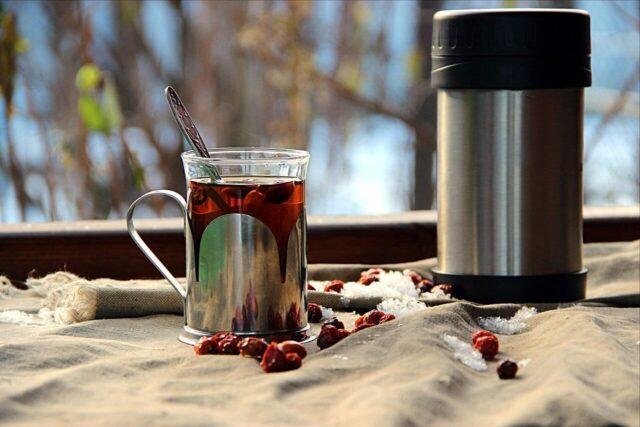
The broth helps to speed up the recovery of the body after an illness.
Application in traditional medicine
This shrub has proven to be effective in treating various diseases. But for this it is necessary to follow the recommendations for the preparation of medicinal products.
With gout
To treat this disease, you need to use the fresh fruits of the plant. They must be washed thoroughly and dried slightly. Then grind the raw materials to a homogeneous consistency. Pour 2 tbsp. l. crushed fruits 200 ml boiling water, cover the container with a lid. After 15 minutes add 400 ml of warm water. Put on low heat and simmer for half an hour.
Take a decoction in the morning and in the evening, 300 ml, cook every day. The course of treatment is 3 months. Then take a break for four weeks, and repeat again.
With pancreatitis
In this case, it is necessary to take a remedy based on needle rose, dosed and without sugar. The daily rate is 150 ml. Exceeding it can lead to health complications.
To prepare a healing agent, you need 200 g of dried fruits, pour 1 liter of boiling water and simmer over low heat for 15 minutes. After that, insist the drink for 8 hours, strain, and then dilute with water in a 1: 1 ratio.
From Staphylococcus aureus
To cope with a pathogenic bacterium, you must use a special infusion. To prepare it, pour 1 tbsp into a thermos. l. dried hawthorn and spiny rose seeds. Pour this mixture with 1 liter of boiling water, leave for 4 hours. Take 100 ml in the morning and evening until complete recovery. If desired, sugar can be added to the healing drink.
To improve heart function and strengthen blood vessels
Flavonoids and ascorbic acid, which are found in large quantities in rose hips, have an antioxidant effect. This helps protect the circulatory system from the negative effects of free radicals.
To prepare a healing agent, it is necessary to grind the dried fruits of the needle rose. Then 1 tbsp. l. pour 400 ml of water into the resulting mixture and cook in a water bath for a quarter of an hour. After that, leave for 30 minutes, drain.
Take the broth twice a day for 20 minutes. before meals in the morning and in the evening, 100 ml. Full course - 1 month. After that, you need to take a break for two weeks, then repeat.
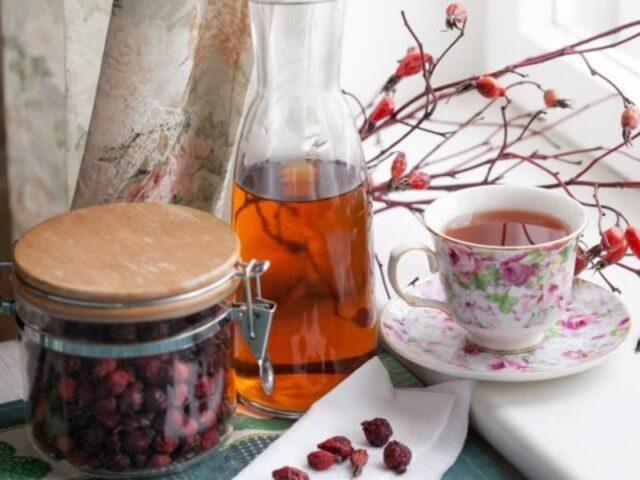
Means based on rose hips should be drunk before meals
From stones and sand in the kidneys
For treatment, it is necessary to use the roots of the needle rose. They must be thoroughly washed and cleaned with a sharp knife. After that, grind the vegetable raw materials with a blender or pass through a meat grinder. Pour 2 tbsp. l. the resulting mixture of 400 ml of water and simmer over low heat for 15-20 minutes.
After cooling, strain the broth. Take the product warm, 80 ml three times a day before meals. The duration of the course of treatment is two weeks. During therapy, you need to drink plenty of water to remove sand and stones from the body.
Contraindications
Despite the benefits of this shrub, in some cases it can be harmful. A high content of ascorbic acid can cause allergies. Therefore, for people with an individual intolerance to this component, it is better to refuse to use funds based on needle rose hips.
Other contraindications:
- gastritis;
- peptic ulcer;
- a predisposition to constipation;
- thrombophlebitis;
- endocarditis;
- hypotension, instability of blood pressure.
You can not use funds based on this shrub and during the exacerbation of other chronic diseases in the body.
It is not contraindicated to drink tea and rosehip infusion during pregnancy and lactation, but their use should be agreed with your doctor.
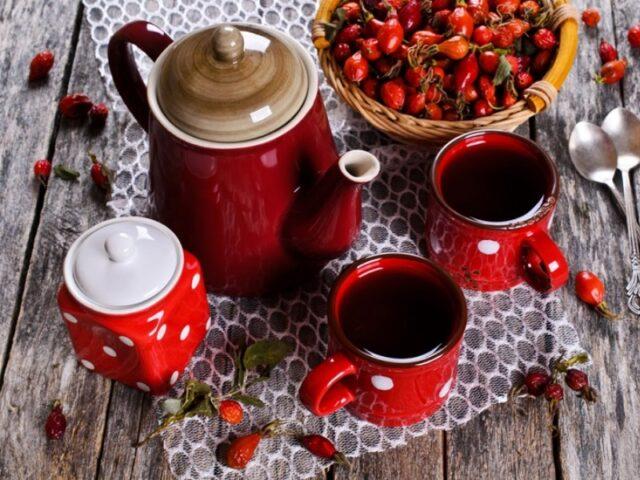
Shrub-based products should not be given to children under the age of two.
Collection and procurement
Healing raw materials need to be harvested at different periods. Rosehip fruits must be harvested after they ripen, when they turn a bright red hue, but before the first frost. It is recommended to harvest in September. After that, the fruits should be dried in the oven at a temperature of + 50-70 degrees.
Collecting the leaves of the needle rose should be carried out in the first half of summer. It is recommended to harvest the petals of the plant during the flowering period. Then the raw material must be dried in a shaded place for several days.
For medicinal purposes, only the lateral roots of the plant are suitable. They need to be dug up in late autumn or early spring. After that, clean from the ground and wash thoroughly. Then cut into small pieces and dry in a shaded place.
It is necessary to store plant materials in paper bags, cardboard boxes, fabric bags in a dry place, excluding exposure to sunlight. The shelf life is 2 years.
Conclusion
Rosehip is a wild shrub that can help solve many health problems. However, it should be understood that this plant is not a panacea for all diseases, and in some cases it can be harmful. Therefore, uncontrolled use of folk remedies based on needle rose is unacceptable. They can only be taken in consultation with your doctor.

